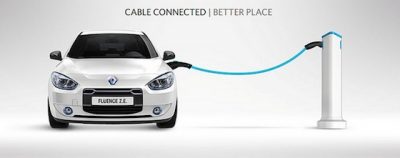 Mod your petrol-run car – and make it electric!
Mod your petrol-run car – and make it electric!
A lot of car buyers today are interested in cutting their carbon footprint – that’s why they want to purchase both hybrid and electric cars.
Hybrids (Karen writes about the pleasures of owning a Prius), are a combination of both a gasoline and electric power source.
Hybrids are becoming very popular in Israel, despite their higher costs. While these cars are more economical to drive, they do not completely solve the exhaust emissions problems as at least 70 -80% of the overall driving is still being done with the gasoline engine.
Then there are full electric cars: currently being developed by Israelis at the company Better Place, these guys have made agreements with both Renault and Nissan for developing full electric vehicles, which are being promoted at the COP 15 climate change conference now on. Full electric cars are still very expensive, however, and beyond the financial reach of many people.
With this in mind, if you don’t have the cash to lay down for a hybrid and can’t wait for a decent full electric solution why not build one of own?
You can convert your old polluting fossil fuel set of wheels to a totally electric one. I’m not referring to slapping a used electric motor from a washing machine onto a go-cart frame, or building a glorified golf cart from a set of plans taken from a back issue of Popular Mechanics (for those who are familiar with this popular American “how to do it” magazine).
A guide on converting a regular gasoline power car (in this case a ’95 Toyota Corolla) to on powered by electricity, appeared recently in an environmental website Residential Solar Power that told how to make this conversion, and on a limited “shoestring” budget at that.
The text there is a little hard to follow and it won’t be easy. Either you have to be mechanically inclined, and have the proper tools and a car lift: to remove the old gasoline engine and exhaust system, and replace it with a suitable electric motor (DC current recommended); and create a “cradle” large enough to accommodate several automobile batteries (that will supply the power).
You also have to alter the car’s hydraulic transmission bit to work with new engine, as well as install a special battery charging unit to recharge to batteries (or do the old way with jumper cables attached to each battery to recharge it once it goes flat).
Supposedly, if all goes well with the conversion, you should wind up having a car that will accelerate off the line much faster than a gasoline driven one, and which should go at least 200 miles (300 km) at a top speed of 50 mph (80 kmh).
That’s okay for city driving, but won’t be good for highway speeds, however. And like having a sexual transgender operation, it would be a bit difficult to revert back to what was before (in this case, what the power source was previously).
There is also the problem on convincing your local governmental authorities, such as the Public Safety Department or Transport Ministry to authorize a license to drive such a car on public streets and roads. The article itself didn’t mention anything on how to deal with this “minor technicality.”
You’re on your own in dealing with this matter. But people who’ve converted their cars to on biodiesel and natural gas, may very well have the same problem.
Other people are trying to convert their cars to run on electricity, including a man in the American state of Mississippi who converted an old VW Scirocco to run on battery power. But his model entails the use of no less than 15 ordinary car batteries to supply the needed power, and the conversion costs much more.
But if the Residential Solar Power article holds true, you may (hopefully) invest only a few hundred dollars, or the equivalent in your local currency, and wind up with an emissions-free car that, besides the cost of replacing worn out batteries, will be environmentally greener to drive and maybe more economical too.
If you have the money, however, it might be better to wait until Renault’s ZE Concept electric car line comes out around the end of 2012.




absolutely I do own and drive an EV. My car uses 12 x 8v deep cycle golf cart batteries. They are a little over a year old, with 4500 miles and about 300 cycles on them. There are LOTS of people that get 600 cycles on them with proper maintenance and not too deep daily depth of discharge. I was not very good about watering mine in the beginning, and so they are showing early signs of age, but still working fine.LiFePO4 batteries are just about all made in China, and ARE expensive… but *should* last 10 years which brings the cost per cycle a little lower than lead-acid, and result in a slightly lower operational cost than gasoline by my numbers… which is my main point. I have NOT read about many 'spontaneous failures' of cells, only failures of BMS systems killing cells, or people that use too big a controller and discharge at too high a rate too often. Sure, its early, and we're all learning… if you stick with what people have learned over the last couple years, I think EVs are at a very drivable and dependable state.I am moving to Li because they are far lighter, have higher capacity, last longer, and I think have established reasonable quality control in the last two years or so. Most of the failures I read about in online Forums these days are from people who installed faulty BMS systems that actually killed the batteries, or used chargers with inappropriate charge curves. I am going WITHOUT a BMS because I think they caue more problems than they solve, and the charger costs around $1000, not $3000.I am not saying EVs are for everyone, or able to be a family's only car. I am saying that in MANY cases electric EVs are perfect for 'around town', and then you can use an ICE vehicle for trips.
Sir do you own a DIY bike or car? I have an EV and EV bike and belong to an EV club. No one gets 600 cycles from a lead acid battery. And LiFePO4 batteries from China (where else can you buy them?) cost thousands and are of poor quality, and usually develop individual cell failures within a few months of purchase. If you press hard enough they will replace the failed cells, which do no match up well with the existing cells. Also with LiFePO4 batteries you have to charge them very carefully, or buy a $3k programmable charger and hope the leads on the Chinese batteries last. Like I said before, DIY EV's are a great hobby, but it's mostly for tinkering in your garage and does not really replace any car you might own.
this article overstates a lot… but DIY evs are better than joepah thinks. 😉 It can cost under $10k to get a conversion running on lead-acid; but yes the range will be 40 miles, and the batteries will last about 500-700 cycles if you treat them well with a net cost per mile on par with cas prices around $2.50 -$2.75 in comparable vehicles.lead-acid batteries are not as bad as joepah might think with an almost 100% closed recycle process in place. Just bring the dead batteries into any auto parts store, and virtually 100% will be turned back into new batteries.the better news is that the LiFePO4 large-format batteries are now less expensive than lead per cycle, and can be used to build a car with up to about 100 mile range for less than $20k. The cost per mile is LESS than gasoline finally!so… the original article is a bit too positive, and joepah a bit too negative… funny how that works. ;)for lots more info from people who are DOING this, check out the site diyelectriccar_dot_org
These cubicle writer articles are always entertaining. DIY EV's are a great hobby and working with your hands is a great stress reliever and it's educational. However, please don't con us to believe that these EV's are a benefit to our planet. Those lead acid batteries are only good for 300-400 charges at most, after that you have to replace them EVERY YEAR.And that picture of 10 batteries, 6 volts each will NOT get 200 miles to a charge. Very misleading.
These cubicle writer articles are always entertaining. DIY EV's are a great hobby and working with your hands is a great stress reliever and it's educational. However, please don't con us to believe that these EV's are a benefit to our planet. Those lead acid batteries are only good for 300-400 charges at most, after that you have to replace them EVERY YEAR.And that picture of 10 batteries, 6 volts each will NOT get 200 miles to a charge. Very misleading.
These cubicle writer articles are always entertaining. DIY EV's are a great hobby and working with your hands is a great stress reliever and it's educational. However, please don't con us to believe that these EV's are a benefit to our planet. Those lead acid batteries are only good for 300-400 charges at most, after that you have to replace them EVERY YEAR.And that picture of 10 batteries, 6 volts each will NOT get 200 miles to a charge. Very misleading.